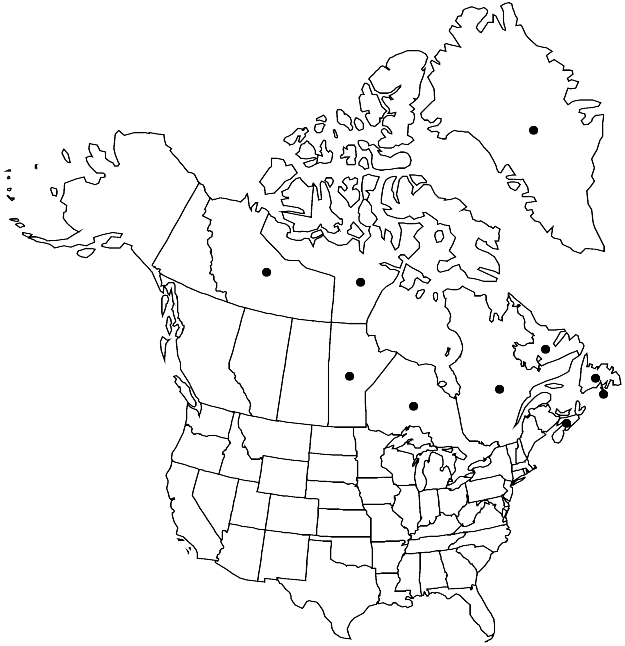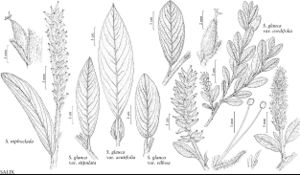Salix glauca var. cordifolia
Phytologia 90: 315. 2008.
Plants 0.2–2.5 m. Stems: branches yellowbrown or redbrown, villous to glabrescent; branchlets densely villous to glabrescent. Leaves: stipules not marcescent, rudimentary or foliaceous on early and late ones, usually inconspicuous, oblong to elliptic or ovate, 1–2.1–4 mm, apex acute to caudate; petiole 2–9 mm, pilose adaxially; largest medial blade (sometimes hemiamphistomatous), sometimes broadly obovate, 17–63 × 6–28 mm, 1.4–3.5 times as long as wide, base sometimes rounded, rarely subcordate, apex sometimes rounded, abaxial surface pilose, moderately densely villous or long-silky to glabrescent, hairs straight or wavy, adaxial (sometimes dull), pilose or villous to glabrescent; proximal blade margins entire or serrulate; juvenile blade sparsely to densely villous or tomentose. Catkins: staminate 10–48 × 5–14 mm, flowering branchlet 2–25 mm; pistillate subglobose or globose, 18–56 (–60 in fruit) × 7–21 mm, flowering branchlet 2–26 mm; floral bract tawny, brown, or bicolor, 2–3 mm, apex rounded, hairs wavy or straight. Staminate flowers: abaxial nectary 0.3–1 mm, adaxial nectary narrowly oblong, oblong, ovate, or flask-shaped, 0.5–1.3 mm; filaments distinct or slightly connate, glabrous, or hairy on proximal 1/2. Pistillate flowers: adaxial nectary 0.4–1.4 mm; stipe 0.3–1.3 mm; ovary pyriform, densely villous or tomentose, beak gradually tapering to styles; ovules 10–18 per ovary; styles connate to distinct 1/2 their lengths or more, 0.7–1.6 mm; stigmas slenderly cylindrical, 0.36–0.48–0.72 mm. Capsules 6–7.5 mm.
Phenology: Flowering late May-late Jul.
Habitat: Sand and cobbles among granitic boulders, sandy alluvium, on exposed eskers, scree slopes, Sphagnum bogs, Empetrum heaths, snowbeds
Elevation: 0-3200 m
Distribution

Greenland, St. Pierre and Miquelon, Man., Nfld. and Labr., N.W.T., N.S., Nunavut, Ont., Que.
Discussion
The taxonomy of var. cordifolia in the Canadian arctic islands and Greenland is confusing. T. W. Böcher (1952) noted what he thought were two ecologically and morphologically different types of Salix glauca occurring in western Greenland: a glabrous type corresponding to S. glauca subsp. callicarpaea and a hairy one corresponding to S. cordifolia var. intonsa. G. W. Argus (1965) proposed that all Greenland material belonged to the eastern phase of S. glauca (corresponding to S. glauca var. cordifolia). Böcher later recognized two taxa on Greenland, S. glauca subsp. callicarpaea (including var. intonsa) and subsp. glauca, which he thought resembled the European S. glauca (Böcher et al. 1968). A. K. Skvortsov (1971) did not agree that European S. glauca occurs on Greenland. He pointed out that the Greenland plants differ by their usually shorter, broader, more obtuse leaves, adaxial leaf surfaces bare and even somewhat slightly glossy, flowering branchlets as long as the catkins themselves, bracts often brownish, stamens often with glabrous filaments, and a more spreading growth form.
Hybrids:
Variety cordifolia forms natural hybrids with Salix arctophila, S. ballii, S. brachycarpa, S. myricoides, and S. pedicellaris. Placement of specimens from Anticosti Island, Quebec, and North Point, James Bay, Ontario, with densely villous branchlets and relatively short petioles, sometimes thought to be hybrids with S. glauca var. cordifolia, is dubious. Hybrids with S. planifolia have been reported (C. K. Schneider 1921) but no convincing specimens have been seen.
Variety cordifolia × Salix myricoides (S. ×amoena Fernald, S. glauca var. tonsa) is a hybrid swarm characterized by buds with ferruginous hairs, leaves serrulate-crenulate and sparsely hairy, except on margins, and ovaries with flattened, refractive hairs. At the type locality on Ha-Ha Mountain, Newfoundland, it is growing in a population of var. cordifolia; S. planifolia, S. ×pedunculata Fernald, and S. candida were growing nearby. The second parent, S. myricoides, occurs some distance south along the coast. It is possible that the unusual vegetative characteristics were derived from S. planifolia, but they best fit S. myricoides.
Variety cordifolia × Salix pedicellaris occurs in northern Quebec. It has the general appearance of var. cordifolia, but the ovaries are mostly glabrous with patches or streaks of hairs, or, sometimes, mostly hairy, and with glabrous basal patches. These hybrids usually are fertile and evidently a cross between a species with hairy ovaries and one with glabrous ovaries. The identification of S. pedicellaris as the second parent is based on the hybrids having leaf surfaces glaucous adaxially, ovaries and capsules glaucous, and stipes as long as 1.6–1.8 mm. Plants without these diagnostic characteristics often have shorter styles (0.4–0.8 mm) and floral bracts (1.8–2.4 mm) than is usual for var. cordifolia.
Selected References
None.
Lower Taxa
"-0.72mm" is not declared as a valid unit of measurement for this property."-4mm" is not declared as a valid unit of measurement for this property.
